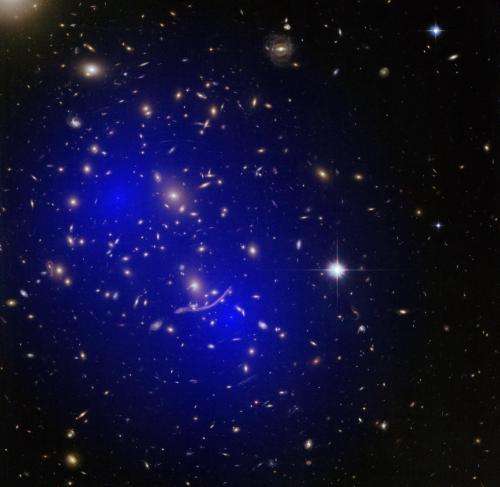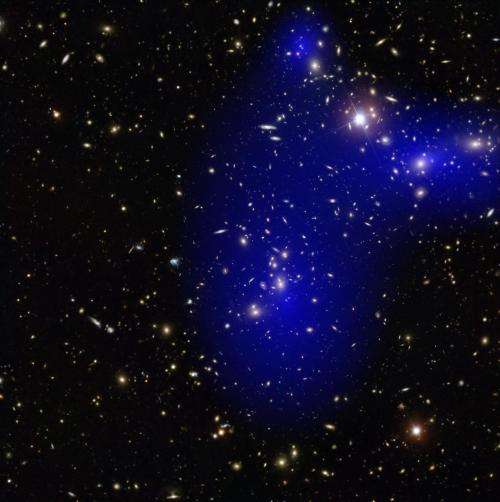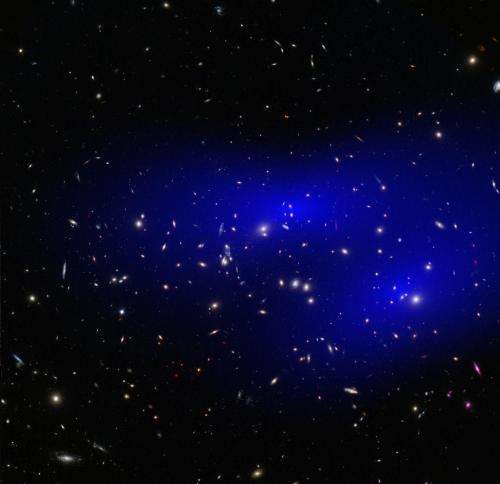Galaxy clusters collide—dark matter still a mystery

When galaxy clusters collide, their dark matters pass through each other, with very little interaction. Deepening the mystery, a study by scientists at EPFL and the University of Edinburgh challenges the idea that dark matter is composed of particles.
Dark matter is one of science's great mysteries. It makes up an enormous amount matter in the universe, it is invisible, and it does not correspond to anything in the realm of our experience. Different theories compete for an explanation, but so far none of them has prevailed. In a collaborative study between École Polytechnique Fédérale de Lausanne (EPFL) and the University of Edinburgh, scientists have studied how dark matter behaves when galaxy clusters collide with each other over billions of years. Published in Science, their findings challenge at least one major theory on dark matter.
Dark matter and galaxy clusters
Although it accounts for 90% of all matter in the universe and more than a quarter of its energy, we know very little about dark matter. One major idea among astronomers is that dark matter consists of a new subatomic particle that we haven't discovered yet. More exotic theories want dark matter to be a quantum defect from the birth of the universe, extra-dimensional mass, and even a modified form of gravity.

What we do know is that dark matter interacts with cosmic structures through gravity, shaping and molding them. For example, dark matter bends light that passes through it, distorting images of distant space objects. In addition, dark matter speeds up the motion of galaxies inside galaxy clusters, which are collections of hundreds of galaxies, containing literally astronomical amounts of stars, planets, and gases. Galaxy clusters are also 90% dark matter, which makes them ideal for studying it, especially when they collide into each other and force their respective dark matters to interact.
Peering into the dark
David Harvey at EPFL's Laboratory of Astrophysics studies galaxy cluster collisions to find clues about the nature of dark matter. Continuing his PhD work from the Royal Observatory at Edinburgh, he and his colleagues studied data from 72 galaxy cluster collisions. These cosmic crashes happen over the course of billions of years when galaxy clusters attract each other because of their gargantuan masses. When this happens, the dark matter in each galaxy cluster interacts with that of the other, offering a unique opportunity to study it.
Harvey's data came from the Chandra X-ray Space Observatory and the Hubble telescope, and included the famous Bullet Cluster collision, a collision of two galaxy clusters whose gas has been molded into the shape of a bullet. This particular collision is actually the best current evidence for the existence of dark matter.

The researchers analyzed the collision data to measure the change in momentum of dark matter when two galaxy clusters crashed into each other. Experiments on Earth, e.g. in the Large Hadron Collider, show us that when subatomic particles interact, they exchange momentum. Therefore, depending on what happened to the dark matter after the collision, the researchers could draw conclusions about its nature.
To test the theory that dark matter consists of particles, the study worked with two possible scenarios: Either the particles of the dark matter interacted frequently but exchanged little momentum, or they interacted rarely but exchanged a lot of momentum. In the first case, dark matter would slow down after the collision, because the frequent particle interactions would cause an additional "drag". In the second scenario, dark matter would tend to be scattered away and lost into space.
Surprisingly, the study discovered that dark matters in galaxy cluster collisions simply pass through each other. This implies that dark matter particles do not interact with themselves, which would have caused dark matter to slow down. Instead, it appears that while dark matter could interact "non-gravitationally" with visible matter, this is not the case when it interacts with itself.
More importantly, the study challenges the view that dark matter consists of proton-like particles - or perhaps any particles whatsoever. "We have now pushed the probability of two 'dark matter particles' interacting below the probability of two actual protons interacting, which means that dark matter is unlikely to consist of just 'dark-protons'," says David Harvey. "If it did, we would expect to see them 'bounce' off each other".
More information: Harvey D, Massey R, Kitching T, Taylor A, Tittley E. The non-gravitational interactions of dark matter in colliding galaxy clusters. Science 27 March 2015. DOI: 10.1126/science.1261381
Journal information: Science
Provided by Ecole Polytechnique Federale de Lausanne


















